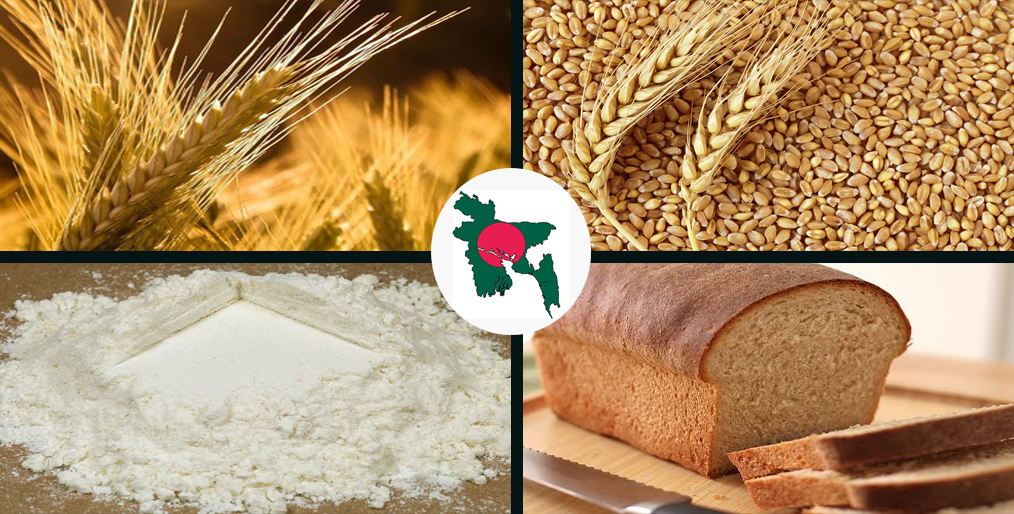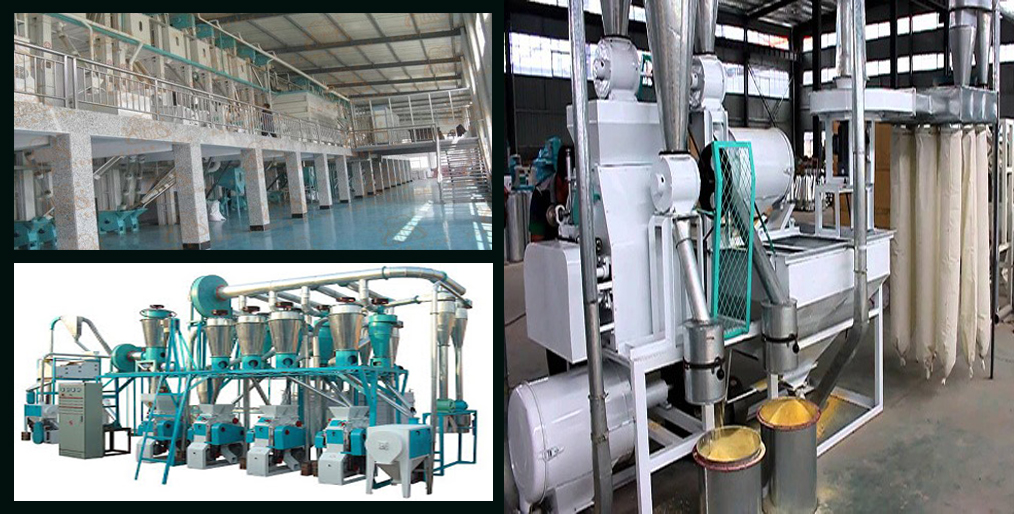
[caption id="attachment_3198" align="aligncenter" width="1014"] File Picture[/caption]
SZ Kabir: Wheat is a grass widely cultivated for its seed, a cereal grain which is a worldwide staple food. The many species of wheat together make up the genus Triticum; the most widely grown is common wheat (T. aestivum). The archaeological record suggests that wheat was first cultivated in the regions of the Fertile Crescent around 9600 BCE. Botanically, the wheat kernel is a type of fruit called a caryopsis. It is a type of sugar diet. Red wheat flour is relatively low in calories. On the other hand, the amount of fiber is higher. As a result, the bread made from red flour is nutritious on one side and healthy on the other.
By the time of independence (1971), Bangladesh had become highly dependent on wheat imports while dietary preferences were changing such that wheat was becoming a highly desirable food supplement to rice. In the first half of the 1980s, domestic wheat production rose to more than 1 million tons year−1, but was still only 7–9 % of total food grain production (BARI 2010). Currently the most cultivated varieties of wheat in this country are Kanchan, Akbar, Agharani and Protiva. Moreover, two high yielding new varieties namely Saurabh (BARI wheat-19) and Gaurav (BARI-wheat-20) have been approved.
For a number of years, Bangladesh has started developing a trade-based framework with its development over the years. As one of the world's top producers of rice production when evaluating agricultural production, the country shows a dependence on import for wheat. By being an active and emerging participant in the global grain market with rising wheat demand, Bangladesh has almost doubled its wheat imports in the last ten years.
Bangladesh has emerged as the fifth largest wheat importer in the world, with its import of the grain increasing by 36 per cent over the past five years, according to a report of the United Nation’s Food and Agriculture Organization (FAO).
[caption id="attachment_3186" align="aligncenter" width="1014"]
File Picture[/caption]
SZ Kabir: Wheat is a grass widely cultivated for its seed, a cereal grain which is a worldwide staple food. The many species of wheat together make up the genus Triticum; the most widely grown is common wheat (T. aestivum). The archaeological record suggests that wheat was first cultivated in the regions of the Fertile Crescent around 9600 BCE. Botanically, the wheat kernel is a type of fruit called a caryopsis. It is a type of sugar diet. Red wheat flour is relatively low in calories. On the other hand, the amount of fiber is higher. As a result, the bread made from red flour is nutritious on one side and healthy on the other.
By the time of independence (1971), Bangladesh had become highly dependent on wheat imports while dietary preferences were changing such that wheat was becoming a highly desirable food supplement to rice. In the first half of the 1980s, domestic wheat production rose to more than 1 million tons year−1, but was still only 7–9 % of total food grain production (BARI 2010). Currently the most cultivated varieties of wheat in this country are Kanchan, Akbar, Agharani and Protiva. Moreover, two high yielding new varieties namely Saurabh (BARI wheat-19) and Gaurav (BARI-wheat-20) have been approved.
For a number of years, Bangladesh has started developing a trade-based framework with its development over the years. As one of the world's top producers of rice production when evaluating agricultural production, the country shows a dependence on import for wheat. By being an active and emerging participant in the global grain market with rising wheat demand, Bangladesh has almost doubled its wheat imports in the last ten years.
Bangladesh has emerged as the fifth largest wheat importer in the world, with its import of the grain increasing by 36 per cent over the past five years, according to a report of the United Nation’s Food and Agriculture Organization (FAO).
[caption id="attachment_3186" align="aligncenter" width="1014"] Flour Mills, File Picture[/caption]
Among the fastest growing importing countries, Bangladesh imported 5.5 million tons of wheat in the last fiscal. FAO predicts this is likely to increase to 6 million tons in the current fiscal year. Even just five years ago, Bangladesh was not among the top 10 wheat importing countries of the world.
Expanding fast-food restaurants and growing export-oriented food processing sectors (Shemai, noodles, breads, biscuits, crackers and other snacks) make Bangladesh an emerging market for high-protein wheat and wheat based products.
According to a survey conducted by the Bangladesh Institute of Development Studies in 2012, the average daily consumption of wheat flour is now 46 grams (67 grams for urban consumers and 25 grams for rural consumers).
The Bangladesh Bureau of Statistics estimates that the purchase of wheat and wheat flour is about 1.5% of total food expenditure. This rate is very low compared to buying rice with a rate of 31.03%. However, wheat constitutes the second essential food of Bangladesh, constituting about 12% of total grain consumption. This situation has made the country a possibility in the field of milling.
Looking at the milling sector of Bangladesh, it is seen that modern roller mills are replacing the commonly used "Chakki "mills rapidly. It is estimated that there are around 2000 “chakki” mills. While the number of small and medium-sized mills is between 300 and 350, the number of large scale mills is around 20. While the wheat processing capacity of large scale mills is between 100 and 500 million tons, the wheat processing capacity of small and medium-sized mills is between 10 and 100 million tons.
Bangladesh wheat mill usually produces one or two grades of "flour" semi-hard wheat flour, commonly used for making flat breads such as "chapatti" and "roti". Mills with more sophisticated equipment can make two or three grades of "Maida" white low-purpose wheat flour also uses traditional oyster snacks like "Singara" “Samucha”, “Luchi”, "puree", pastry, different types of cake and loaf style breads.
[caption id="attachment_3187" align="aligncenter" width="1014"]
Flour Mills, File Picture[/caption]
Among the fastest growing importing countries, Bangladesh imported 5.5 million tons of wheat in the last fiscal. FAO predicts this is likely to increase to 6 million tons in the current fiscal year. Even just five years ago, Bangladesh was not among the top 10 wheat importing countries of the world.
Expanding fast-food restaurants and growing export-oriented food processing sectors (Shemai, noodles, breads, biscuits, crackers and other snacks) make Bangladesh an emerging market for high-protein wheat and wheat based products.
According to a survey conducted by the Bangladesh Institute of Development Studies in 2012, the average daily consumption of wheat flour is now 46 grams (67 grams for urban consumers and 25 grams for rural consumers).
The Bangladesh Bureau of Statistics estimates that the purchase of wheat and wheat flour is about 1.5% of total food expenditure. This rate is very low compared to buying rice with a rate of 31.03%. However, wheat constitutes the second essential food of Bangladesh, constituting about 12% of total grain consumption. This situation has made the country a possibility in the field of milling.
Looking at the milling sector of Bangladesh, it is seen that modern roller mills are replacing the commonly used "Chakki "mills rapidly. It is estimated that there are around 2000 “chakki” mills. While the number of small and medium-sized mills is between 300 and 350, the number of large scale mills is around 20. While the wheat processing capacity of large scale mills is between 100 and 500 million tons, the wheat processing capacity of small and medium-sized mills is between 10 and 100 million tons.
Bangladesh wheat mill usually produces one or two grades of "flour" semi-hard wheat flour, commonly used for making flat breads such as "chapatti" and "roti". Mills with more sophisticated equipment can make two or three grades of "Maida" white low-purpose wheat flour also uses traditional oyster snacks like "Singara" “Samucha”, “Luchi”, "puree", pastry, different types of cake and loaf style breads.
[caption id="attachment_3187" align="aligncenter" width="1014"] Foods made from Bangladeshi flour, File Picture[/caption]
It has been clearly seen that mills pay more attention to wheat procurement and end-use targets in mills in recent years. The expansion of fast-food restaurants and the growing export-oriented food processing sector (noodles, bread, biscuits, crackers and other snacks) suggest that Bangladesh is an emerging market for high protein based wheat and wheat-based products.
Usually the wheat available in the local market is mixed with corn. Corn production has also increased to 39 million tons last year. Most of the corn is mixed with wheat to prepare poultry and fish feed.
Rice is the most important cereal used in the country and wheat is the second most commonly used cereal type. It is estimated that the total cereal consumed per capita is 238 kg and wheat is 7% of this amount.
Physicians advise eating roti (flat bread) instead of rice to control blood sugar levels. Apart from this, many people eat rice once a day and bread in the two meals other meals, out of health awareness. There is thus an increased consumption of roti, bread and wheat products in the country.
As a result of the increase in income levels in the country, bread varieties and bakery products have taken place in supermarkets in major cities of the country. In this view, it is considered that the demand for raw materials for these products and other additives will increase at a later time.
Foods made from Bangladeshi flour, File Picture[/caption]
It has been clearly seen that mills pay more attention to wheat procurement and end-use targets in mills in recent years. The expansion of fast-food restaurants and the growing export-oriented food processing sector (noodles, bread, biscuits, crackers and other snacks) suggest that Bangladesh is an emerging market for high protein based wheat and wheat-based products.
Usually the wheat available in the local market is mixed with corn. Corn production has also increased to 39 million tons last year. Most of the corn is mixed with wheat to prepare poultry and fish feed.
Rice is the most important cereal used in the country and wheat is the second most commonly used cereal type. It is estimated that the total cereal consumed per capita is 238 kg and wheat is 7% of this amount.
Physicians advise eating roti (flat bread) instead of rice to control blood sugar levels. Apart from this, many people eat rice once a day and bread in the two meals other meals, out of health awareness. There is thus an increased consumption of roti, bread and wheat products in the country.
As a result of the increase in income levels in the country, bread varieties and bakery products have taken place in supermarkets in major cities of the country. In this view, it is considered that the demand for raw materials for these products and other additives will increase at a later time.
Comment Now